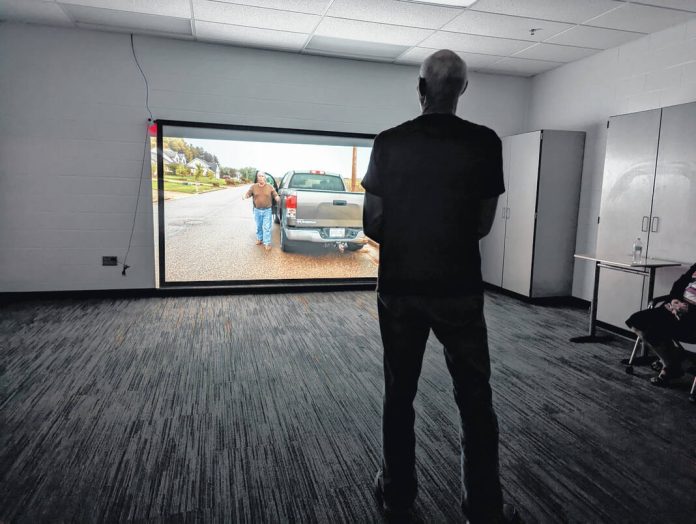
Rossford Citizen’s Police Academy student Tom Kaczynski holds a modified handgun while using the multimedia interactive MILO Range simulation unit at the Penta Career Center Academy.
ROSSFORD — Rossford Citizen’s Police Academy students took part in the multi-media interactive training room at the Penta Career Center.
The final Wednesday class of the nine-week course included three training subjects: the MILO Range simulator, a body camera discussion and an introduction to Oggy the therapy dog.
Penta has a room dedicated to the MILO Range, an interactive use-of-force and firearms training simulator. It utilizes a real Glock handgun — that has been converted to firing a laser — into an interactive theater system which provides real-world scenarios.
The system is not like the old police movies, where a target pops up in a building and the officer decides whether or not to shoot the person-shaped target.
Rossford Police Chief Kitzler gave the students basic instructions.
“Basically what (the gun) does is it projects an image onto the screen,” Kitzler said of the laser projecting gun. “You can walk around, go at (the subject), or whatever, but it’s life-size. People will appear. They will talk to you and you can talk back. The ultimate goal with a lot of these scenarios is to de-escalate.”
Each class member did several different scenarios, with many not involving a weapon. When weapons were discharged, the MILO unit showed where anyone was hit, including the officer, and whether or not someone was killed.
“It was a lot of thinking, on-the-fly,” said student Tim Miller, who had been hit with a taser in a previous class.
In the debriefing, Kitzler, Lt. Craig Revill and Penta criminal justice instructor Michael Willford each gave suggestions, with some scenarios re-run, to show alternate solutions. Some calls were for suicide cases, domestic violence, intoxicated individuals and traffic stops.
One case had a retired police officer who was drunk and suicidal.
“There are a couple schools of thought on this one, if you want him to take the gun out himself and put it on the table, or if you want to take it from him. That’s a tough call. To me, I don’t want him to pull it out on his own. He could shoot himself with it, or shoot you with it,” Kitzler said. “You can see, we’re not social workers, but that’s what they want us to be. That’s where they are trying to teach us in crisis intervention training, to try to talk to people and get some trust built.”
Kitzler and Willford presented alternate views of the situations, including situations in which a person might not be allowed to have a handgun, such as when they are intoxicated.
“These are situations we run into on the street, in Ohio we have concealed carry and open carry,” Willford said. “These are factors we have to take into account, like in traffic stops. Is he allowed to have it?
“People in Ohio, they know their rights,” he said.
Student Tom Kaczynski was amazed at the realism of the simulator.
“It wasn’t what I expected. I wasn’t expecting to be in situations like a real police officer, like with random stops,” he said. “As a participant in this, you’re concerned about your well being. I thought the worst scenario. The guy came out with a gun and he didn’t respond to my command. It’s stressful, very much so.”
The MILO simulator was followed by Officer Keon Domanski’s talk about body cameras.
He talked about the benefits of the cameras, both to the officer and the public.
“The truth can be preserved,” Domanski said.
Even when the officer doesn’t have the unit turned on, it is still has a recall, for up to 18 hours, with audio-free incidents that are uploaded to the digital cloud, he said.
Questions of privacy also came up.
Kitzler said that early in the adoption of the camera system there were questions about privacy, with the information being considered public information. However, the cameras come with software that allows for redaction.
Jodi Johnson, school resource officer, introduced Oggy the therapy dog, which she called the future of dogs in police departments.
“It’s unbelievable what one dog can do for 900 students,” Johnson said. “It’s not cool in high school to talk to a cop, but it’s good to talk with a dog.”
She said that the dog can de-escalate a situation in a way that is not possible with an officer, because there is an empathy involved for both the students that she works with, and the dog.




